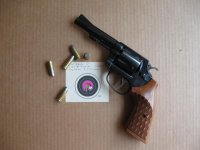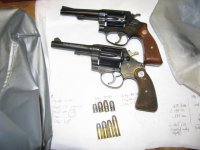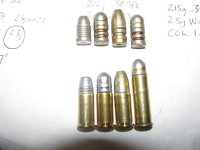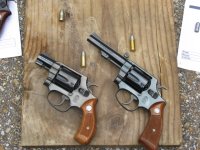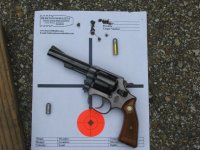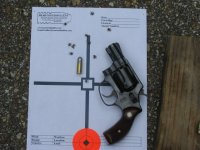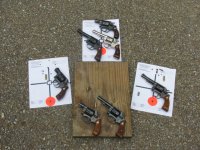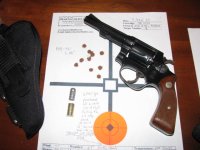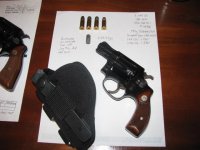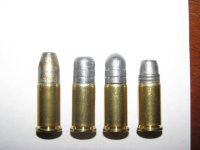March updates on .38/200 testing
200g flat-nose bullets in .38 S&W--penetration testing 7 MAR 10
I used a die made by "BUCKSHOT" on Cast Boolits to flatten the noses of my 192g wheelweight 358430s, giving them a meplat approx. .275 in diameter, while reducing the LRN profile to something resembling a LWC without the sharp shoulder. Since the flattening process caused a bit of swelling, I ran them thru a 361 sizer to ensure a fit in my guns. I also reduced the charge from 2.7g Win231 to 2.6g, since diameter might have increased from as-cast .360 to .361. COL was reduced from 1.270 to 1.205" due to the bumping process; bullet seating depth was not altered from my earlier tests.
CHRONO RESULTS (10 shots, 4" bb. Mod. 33-1): LO 608.8 HI 643.0 AVG 629.8 ES 34.28 SD 9.43
PENETRATION RESULTS @ est. 10' vs. water-filled milk jugs:
1. 4" bbl, Mod. 33-1. Shot chrono'ed at 604.5fps. Bullet penetrated all 6 jugs in essentially straight line, barely exiting 6th jug, denting a stop board about 1/4" deep, then falling back into the jug (now very clean). I had placed cardboard between each jug, to see whether evidence of bullet tumbling existed. Neither the holes in the cardboard nor the holes in the jugs evidenced tumbling. Since the velocity was actually lower than the chronographed LRN 198g in my earlier testing, the LFP profile seems to account for increased penetration & straighter flight path vs. the LRN version of this bullet.
2. 2" bbl, S&W Mod. 32-1. This shot screamed over the chrono at 575.0 fps, penetrating in a straight line into the 6th jug, but failing to exit. This bullet was also recovered in a very clean condition

No evidence of tumbling.
3. Both recovered bullets miked at .360 and evidenced no weight loss or deformation.
ACCURACY RESULTS: 50' off sandbags, 2 1/2" group 10 rds, POI +5", L 1 1/2".
ADDITIONAL ANALYSIS:
1. Penetration in LFP profile is markedly deeper & straighter than LRN profile of same bullet, despite lower velocity of the shot. The bullet hole is clearly larger and rounder in both paper target and mik jug than the LRN; larger wound channel and greater tissue damage are therefore likely. If any benefit obtains when the bullet tumbles in LRN form, however, this would be lost in LFP form.
2. 192g LFP penetration is slightly less than 161g LSWC and 215g LFP (35-200). The meplat and bullet hole sizes of the 192g LFP and 161g LSWC are very similar; both are larger than the LRN, which is in turn larger than the 215g LFP.
Next tests are with a Lyman Ideal 360271 mold, nominally 150g, which casts 50-50 in WW-Pb + tin at .364+ and 157g lubed.
Cartridge photos below are (L-R):
1. 215g LFP (RCBS 35-200). This is a .35 Remington fifle bullet. Loaded in .38 S&W, it resembles the British 178g FMJ in shape, and the tumble-lube almost makes it look jacketed.
2. 358430 "bumped" from LRN to LFP
3. 358430 in original LRN
4. 161g LSWC (Lee 358-158-SWC-TL)

